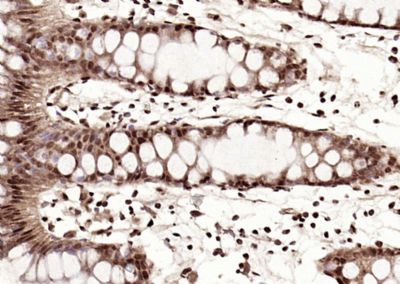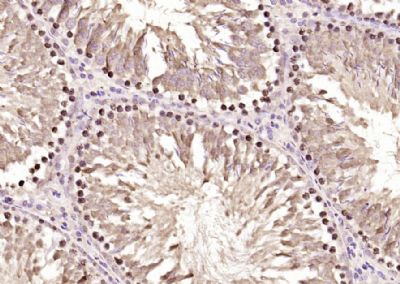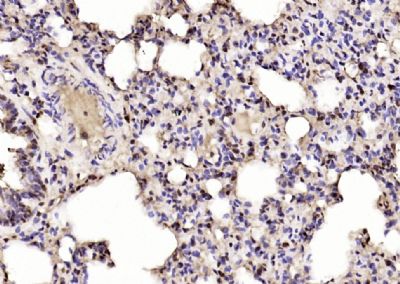| 中文名稱 | 胰島素樣生長因子ⅡmRNA結(jié)合蛋白1抗體 |
| 別 名 | CRD BP; Coding region determinant-binding protein; CRD-BP; CRDBP; IF2B1; IF2B1_HUMAN; IGF II mRNA binding protein 1; IGF-II mRNA-binding protein 1; IGF2 mRNA binding protein 1; IGF2 mRNA-binding protein 1; IGF2BP1; IMP 1; IMP-1; IMP1; Insulin like growth factor 2 mRNA binding protein 1; Insulin-like growth factor 2 mRNA-binding protein 1; VICKZ family member 1; VICKZ1; ZBP 1; ZBP-1; ZBP1; Zip code binding protein 1; Zip code-binding protein 1; Zipcode binding protein 1; Zipcode-binding protein 1. |
| 研究領(lǐng)域 | 腫瘤 細(xì)胞生物 信號轉(zhuǎn)導(dǎo) 表觀遺傳學(xué) |
| 抗體來源 | Rabbit |
| 克隆類型 | Polyclonal |
| 交叉反應(yīng) | Human, Mouse, Rat, (predicted: Chicken, Dog, Pig, Cow, Horse, Rabbit, Zebrafish, Sheep, ) |
| 產(chǎn)品應(yīng)用 | ELISA=1:500-1000 IHC-P=1:100-500 IHC-F=1:100-500 ICC=1:100-500 IF=1:100-500 (石蠟切片需做抗原修復(fù)) not yet tested in other applications. optimal dilutions/concentrations should be determined by the end user. |
| 分 子 量 | 63kDa |
| 細(xì)胞定位 | 細(xì)胞核 細(xì)胞漿 細(xì)胞膜 |
| 性 狀 | Liquid |
| 濃 度 | 1mg/ml |
| 免 疫 原 | KLH conjugated synthetic peptide derived from human IGF2BP1/IMP1:31-130/577 |
| 亞 型 | IgG |
| 純化方法 | affinity purified by Protein A |
| 儲 存 液 | 0.01M TBS(pH7.4) with 1% BSA, 0.03% Proclin300 and 50% Glycerol. |
| 保存條件 | Shipped at 4℃. Store at -20 °C for one year. Avoid repeated freeze/thaw cycles. |
| PubMed | PubMed |
| 產(chǎn)品介紹 | IGF-II mRNA-binding proteins (IMP) bind RNA and influence RNA synthesis and metabolism. IMPs, IMP-1 (coding region determinant-binding protein/insulin-like growth factor II mRNA-binding protein, CRD-BP, VICKZ1), IMP-2 (IMP2, VICKZ2, p62) and IMP-3 (KOC1, VICKZ3), contain a unique combination of RNA recognition motifs and four hnRNP K homology domains. IMP-1 is abundant in embryonal tissues and in 81% of colon cancers, 58.5% of breast cancers and 73% of sarcomas. IMP-1 recognizes c-Myc, IGF-II and tau mRNAs, and H19 RNA and plays a major role in proliferation of K-562 cells by an IGF-II-dependent mechanism. IMP-2 binds the 5' UTR of IGF-II mRNA and influences tumor cell growth, in which IMP-2 is associated with apoptosis induced by tretinoin. IMP-3 knock down by RNA interference decreases levels of IGF-II protein without affecting IGF-II, c-Myc, or b Actin mRNA and H19 RNA levels. IMP-3 is a marker for carcinomas and high-grade dysplastic lesions of pancreatic ductal epithelium. Function: RNA-binding factor that affects mRNA nuclear export, localization, stability and translation. Component of the CRD-mediated complex that promotes MYC mRNA stabilization. Regulates mRNA stability during the integrated cellular stress response (ISR) in stress granules (SGs). Stabilizes the BTRC/FBW1A mRNA from degradation by disrupting miRNA-dependent interaction with AGO2. Identified in a HCV IRES-mediated translation complex, that enhances translation at the Hepatitis C virus (HCV) RNA-replicon via the internal ribosome entry site (IRES), but does not affect 5'cap-dependent translation. Acts as a HIV-1 retrovirus restriction factor that reduces HIV-1 assembly by inhibiting viral RNA packaging, assembly and processing of HIV-1 GAG protein on cellular membranes. Binds to mRNAs in stress granules (SGs). Binds to the stem-loop IV of the 5'-UTR and to the variable region and the poly(U-C) motif of the 3'-UTR of the HCV RNA-replicon. Binds to the 5'-UTR of the insulin-like growth factor 2 (IGF2) mRNA and regulates its subcellular localization and translation. Binds both to the coding region mRNA stability determinant (CRD) and to AU-rich sequences in the 3'-UTR of the MYC and CD44 mRNAs and stabilizes these mRNAs. Binds to the fourth and fifth exons of the oncofetal H19 and neuron-specific TAU mRNAs and regulates their localizations. Binds to the adenine-rich autoregulatory sequence (ARS) 5'-UTR of the PABPC1 mRNA and is involved in its translational repression. The RNA-binding activity to ARS is stimulated by PABPC1. Binds to the coding sequence region of BTRC/FBW1A mRNA and mediates stabilization of BTRC/FBW1A and MYC mRNAs in response to beta-catenin signaling. Binding to RNA employs a cooperative, sequential mechanism of homo- or heterodimerisation. Also involved in growth or survival of lung-cancer cells. Protects the MYC and MDR-1 mRNAs from cleavage by a endoribonuclease, thus prolonging their stabilities (By similarity). Binds to the 3'-UTR axonal localization signal (ALS) of TAU mRNA (By similarity). Binds to a conserved 54-nucleotide element in the 3'-UTR of the beta actin mRNA known as the 'zipcode' (By similarity). Promotes translocation of the beta-actin mRNA to dendrites (By similarity). May act as a regulator of mRNA transport to activated synapses in response to synaptic activity (By similarity). Subunit: Can form homodimers and heterodimers with IGF2BP1 or IGF2BP3. Component of the coding region determinant (CRD)-mediated complex, composed of DHX9, HNRNPU, IGF2BP1, SYNCRIP and YBX1. Identified in a HCV IRES-mediated translation complex, at least composed of EIF3C, IGF2BP1, RPS3 and HCV RNA-replicon. Interacts (via the KH domains) with HIV-1 GAG (via the second zinc finger motif of NC). Associates (via the RRM domains and KH domains) with HIV-1 particles. Identified in a mRNP complex, at least composed of DHX9, DDX3X, ELAVL1, HNRNPU, IGF2BP1, ILF3, PABPC1, PCBP2, PTBP2, STAU1, STAU2, SYNCRIP and YBX1. Identified in a mRNP granule complex, at least composed of ACTB, ACTN4, DHX9, ERG, HNRNPA1, HNRNPA2B1, HNRNPAB, HNRNPD, HNRNPL, HNRNPR, HNRNPU, HSPA1, HSPA8, IGF2BP1, ILF2, ILF3, NCBP1, NCL, PABPC1, PABPC4, PABPN1, RPLP0, RPS3, RPS3A, RPS4X, RPS8, RPS9, SYNCRIP, TROVE2, YBX1 and untranslated mRNAs. Interacts with DHX9, ELAVL2, HNRNPA2B1, HNRNPC, HNRNPH1, HNRNPU, IGF2BP2, IGF2BP3, ILF2, PABPC1 and YBX1. Found in a RNP granule complex with FMR1. Interacts with FMR1. Component of a multi subunit autoregulatory ribonucleoprotein complex (ARC), at least composed of IGF2BP1, PABPC1 and CSDE1. Interacts through the third and fourth KH domains with PABPC1 in a RNA-independent manner. Component of a TAU mRNP complex, at least composed of IGF2BP1, ELAVL4 and G3BP (By similarity). Interacts with ELAVL4 in a RNA-dependent manner (By similarity). Associates with microtubules and polysomes (By similarity). Interacts with EIF2C1 and EIF2C2. Subcellular Location: Nucleus. Cytoplasm. Cell projection, lamellipodium. Cell projection, dendrite (By similarity). Cell projection, dendritic spine (By similarity). Note=Localized in cytoplasmic mRNP granules containing untranslated mRNAs. Targeted to stress granules (SGs), but not processing bodies (PBs), during cellular stress. Colocalizes with G3BP1 and TIAL1 in SGs. Colocalizes with HIV-1 GAG at the cell edges. Found in lamellipodia of the leading edge, in the perinuclear region, and beneath the plasma membrane. The subcytoplasmic localization is cell specific and regulated by cell contact and growth. Colocalized with H19 RNA at lamellipodia. Colocalized with CD44 mRNA in RNP granules. Nuclear export is mediated by XPO1/CRM1. In motile cells, is transported towards the leading edge into the cortical region of the lamellipodia where it is connected to microfilaments (By similarity). Present in the form of granules and into F-actin-rich protrusion of dendrites, spines and subsynaptic sites (By similarity). Colocalizes with beta-actin mRNA in dendrites and spines (By similarity). Exhibited rapid, bidirectional movements in dendrites and spines (By similarity). Neuronal depolarization by KCl induces its rapid efflux from the cell body into dendrites (By similarity). Tissue Specificity: Expressed in fetal liver, fetal lung, fetal kidney, fetal thymus, fetal placenta, fetal follicles of ovary, gonocytes of testis, oocytes, spermatogonia and semen (at protein level). Expressed in testicular and lung cancer (at protein level). Expressed in kidney, prostate, trachea, testis and lung cancer. DISEASE: Phosphorylated. Phosphorylation may influence mRNA translation (By similarity). Similarity: Belongs to the RRM IMP/VICKZ family. Contains 4 KH domains. Contains 2 RRM (RNA recognition motif) domains. SWISS: Q9NZI8 Gene ID: 10642 Database links: Entrez Gene: 395953 Chicken Entrez Gene: 516853 Cow Entrez Gene: 491064 Dog Entrez Gene: 100055918 Horse Entrez Gene: 10642 Human Entrez Gene: 140486 Mouse Entrez Gene: 303477 Rat Entrez Gene: 558182 Zebrafish Omim: 608288 Human SwissProt: O42254 Chicken SwissProt: Q9NZI8 Human SwissProt: O88477 Mouse SwissProt: Q8CGX0 Rat SwissProt: Q08CK7 Zebrafish Unigene: 144936 Human Unigene: 294769 Mouse Unigene: 485325 Mouse Unigene: 77572 Rat Important Note: This product as supplied is intended for research use only, not for use in human, therapeutic or diagnostic applications. |
| 產(chǎn)品圖片 |  Paraformaldehyde-fixed, paraffin embedded (human colon carcinoma); Antigen retrieval by boiling in sodium citrate buffer (pH6.0) for 15min; Block endogenous peroxidase by 3% hydrogen peroxide for 20 minutes; Blocking buffer (normal goat serum) at 37°C for 30min; Antibody incubation with (IGF2BP1) Polyclonal Antibody, Unconjugated (bs-8683R) at 1:200 overnight at 4°C, followed by operating according to SP Kit(Rabbit) (sp-0023) instructionsand DAB staining. Paraformaldehyde-fixed, paraffin embedded (human colon carcinoma); Antigen retrieval by boiling in sodium citrate buffer (pH6.0) for 15min; Block endogenous peroxidase by 3% hydrogen peroxide for 20 minutes; Blocking buffer (normal goat serum) at 37°C for 30min; Antibody incubation with (IGF2BP1) Polyclonal Antibody, Unconjugated (bs-8683R) at 1:200 overnight at 4°C, followed by operating according to SP Kit(Rabbit) (sp-0023) instructionsand DAB staining. Paraformaldehyde-fixed, paraffin embedded (rat testis); Antigen retrieval by boiling in sodium citrate buffer (pH6.0) for 15min; Block endogenous peroxidase by 3% hydrogen peroxide for 20 minutes; Blocking buffer (normal goat serum) at 37°C for 30min; Antibody incubation with (IGF2BP1) Polyclonal Antibody, Unconjugated (bs-8683R) at 1:200 overnight at 4°C, followed by operating according to SP Kit(Rabbit) (sp-0023) instructionsand DAB staining. Paraformaldehyde-fixed, paraffin embedded (rat testis); Antigen retrieval by boiling in sodium citrate buffer (pH6.0) for 15min; Block endogenous peroxidase by 3% hydrogen peroxide for 20 minutes; Blocking buffer (normal goat serum) at 37°C for 30min; Antibody incubation with (IGF2BP1) Polyclonal Antibody, Unconjugated (bs-8683R) at 1:200 overnight at 4°C, followed by operating according to SP Kit(Rabbit) (sp-0023) instructionsand DAB staining. Paraformaldehyde-fixed, paraffin embedded (rat lung); Antigen retrieval by boiling in sodium citrate buffer (pH6.0) for 15min; Block endogenous peroxidase by 3% hydrogen peroxide for 20 minutes; Blocking buffer (normal goat serum) at 37°C for 30min; Antibody incubation with (IGF2BP1) Polyclonal Antibody, Unconjugated (bs-8683R) at 1:200 overnight at 4°C, followed by operating according to SP Kit(Rabbit) (sp-0023) instructionsand DAB staining. Paraformaldehyde-fixed, paraffin embedded (rat lung); Antigen retrieval by boiling in sodium citrate buffer (pH6.0) for 15min; Block endogenous peroxidase by 3% hydrogen peroxide for 20 minutes; Blocking buffer (normal goat serum) at 37°C for 30min; Antibody incubation with (IGF2BP1) Polyclonal Antibody, Unconjugated (bs-8683R) at 1:200 overnight at 4°C, followed by operating according to SP Kit(Rabbit) (sp-0023) instructionsand DAB staining. Tissue/cell: mouse embryo tissue; 4% Paraformaldehyde-fixed and paraffin-embedded; Tissue/cell: mouse embryo tissue; 4% Paraformaldehyde-fixed and paraffin-embedded;Antigen retrieval: citrate buffer ( 0.01M, pH 6.0 ), Boiling bathing for 15min; Block endogenous peroxidase by 3% Hydrogen peroxide for 30min; Blocking buffer (normal goat serum,C-0005) at 37℃ for 20 min; Incubation: Anti-IGF2BP1 Polyclonal Antibody, Unconjugated(bs-8683R) 1:200, overnight at 4°C, followed by conjugation to the secondary antibody(SP-0023) and DAB(C-0010) staining |









